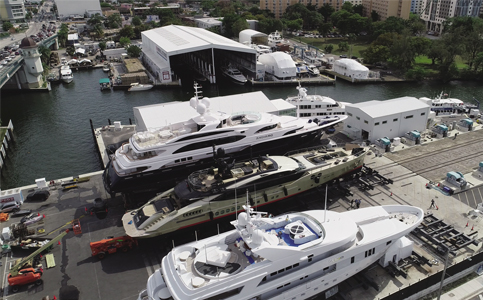Over the last five years, Miami’s maritime industry has experienced a persistent labor shortage that remains unresolved. A key part of the solution may lie in the classroom.
In 2020, Miami Today first highlighted this issue, noting the high demand for skilled labor in the marine service industry—a challenge that was worsened by the Covid-19 pandemic, which affected many industries nationwide. However, five years later, the gap between the supply of skilled marine workers and industry demand has yet to close.
Horacio Stuart Aguirre, chairman of the Miami River Commission, attributes the ongoing shortage to several factors. Most notably, the increasing technological standards of boats, high labor costs, and a lack of awareness and accessible training programs in the marine service industry.
“A long, long time ago, the marine industry was not so complicated,” Aguirre explains. “Over time, technology has crept into the industry—similar to kitchen appliances and cars—and now, maintaining and repairing boats has become very technical. What once could be done with just a hammer and screwdriver is no longer sufficient. Today’s skills only work on simple wooden canoes. Modern boats are technological marvels, and maintaining them requires specialized knowledge in computer engineering, mathematics, physics, and other subjects.”
Aguirre emphasizes that today’s boats incorporate advanced design and technology, making them complex and demanding higher levels of technical expertise. While the pandemic worsened this labor shortage, he points out that the problem has been brewing for over a decade. Contributing factors include increased competition along the East Coast, an undereducated workforce, and prohibitively high costs for both labor and training.
“At one time, South Florida dominated the recreational boating industry, alongside Fort Lauderdale,” Aguirre notes. “But now, that industry has expanded up the entire East Coast and West Coast. Part of this shift was because regions further north developed well-trained marine tradespeople, attracting skilled workers away from South Florida.”
Similarly, Anil Akgun, CFO of Miami’s oldest shipyard, RMK Merrill-Stevens, highlights the growing competition in the region. “Fort Lauderdale is becoming increasingly attractive for boat manufacturing and brokerage firms,” he says. “The issue is workforce migration—talented workers are moving to other areas, seeking better opportunities.”
Akgun stresses the importance of cultivating the next generation of marine industry workers through technical education. “Most current employees are ‘old-school,’ and it’s crucial to have technical schools offering marine-related classes,” he explains. “We need people with experience in marine technologies or naval engineering. Across the U.S., there’s a significant scarcity of shipbuilding knowledge and experience. Additionally, workers are looking elsewhere for better wages and opportunities.”
To address these challenges, the Miami River Commission is actively working to enhance education and training initiatives. One major effort involves collaborating with Miami-Dade County Public Schools to develop a vocational training program for the marine industry, modeled after the program at George T. Baker Technical College.
School board member Danny Espino has been a key advocate in these efforts. He is working on expanding access to technical programs and combating the negative stigma associated with manual trades.
“For too long, society has convinced parents and students that a college degree is the only path to success,” Espino states. “Trades are often seen as less desirable or less rewarding. It’s critical to promote career and technical education (CTE) from an early age so students are aware of these opportunities and know how to pursue them.”
Espino also proposed developing a naval engineering program suited to Miami’s maritime industry. Currently, the county offers a marine services program at Lindsay Hopkins Technical College, providing students with 1,350 hours of hands-on experience. The goal is to create apprenticeship programs that could provide between 6,000 and 7,500 hours of training, although access to such programs remains limited.
“Raising public awareness and changing perceptions about careers in marine trades is our biggest challenge,” Espino admits. “Decades of negative stigma have made these jobs seem dirty or undesirable. We need to show people what the industry actually involves, how rewarding it can be, and that completing programs through Miami-Dade County Public Schools can be an affordable and valuable pathway.”
The River Commission is focused on securing partnerships and funding to support these educational initiatives, while also assessing the evolving needs of Miami’s maritime sector.
“The industry here is strong and has the potential to flourish once again,” Aguirre affirms. “For that to happen, we must invest in the education and training that these trades demand. We want Miami’s maritime industry to reclaim the prominent position it once held.”
https://www.miamitodaynews.com/2025/11/05/a-marine-school-floated-to-close-labor-force-gulf/



